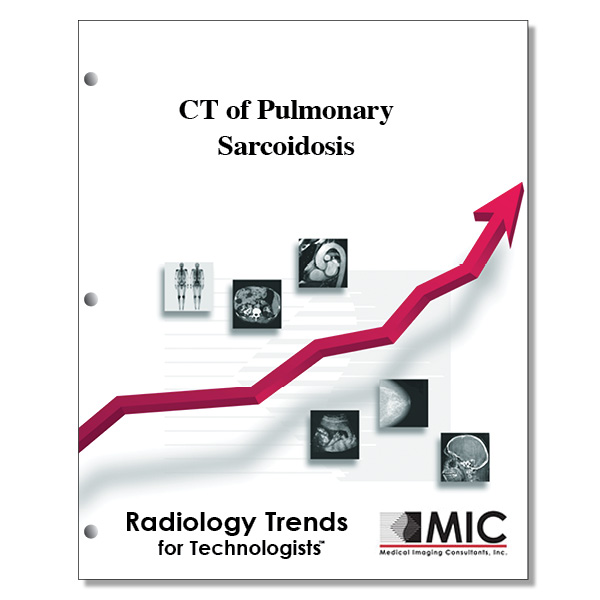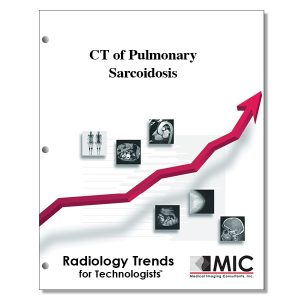

CT of Pulmonary Sarcoidosis
The role of high-resolution CT in the diagnosis and management of pulmonary sarcoidosis.
Course ID: Q00329 Category: Radiology Trends for Technologists Modalities: CT, Radiography3.0 |
Satisfaction Guarantee |
$34.00
- Targeted CE
- Outline
- Objectives
Targeted CE per ARRT’s Discipline, Category, and Subcategory classification for enrollments starting after June 11, 2024:
[Note: Discipline-specific Targeted CE credits may be less than the total Category A credits approved for this course.]
Computed Tomography: 2.50
Procedures: 2.50
Neck and Chest: 2.50
Radiography: 1.25
Procedures: 1.25
Thorax and Abdomen Procedures: 1.25
Registered Radiologist Assistant: 3.00
Procedures: 3.00
Thoracic Section: 3.00
Outline
- Introduction
- Epidemiology
- Clinical Features
- Pathogenesis
- Histologic Findings
- Staging and Prognosis
- Diagnosis
- Use of High-Resolution CT
- Radiologic-Pathologic Correlation
- Typical Patterns of Lymphadenopathy
- Atypical Patterns of Lymphadenopathy
- Typical Parenchymal Manifestations
- Micronodules with a Perilymphatic Distribution
- Fibrotic Changes
- Bilateral Perihilar Opacities
- Atypical Parenchymal Manifestations
- Pulmonary Nodules and Masses
- Patchy Airspace Consolidation
- Patchy Ground-Glass Opacities
- Linear Reticular Opacities
- Fibrocystic Changes
- Honeycomb-like Cysts
- Cavitation of Parenchymal Lesions
- Mycetoma Formation
- Miliary Opacities
- Airway Involvement
- Mosaic Attenuation Pattern
- Air Trapping
- Tracheobronchial Abnormalities
- Atelectasis
- Pleural Disease
- Pleural Plaquelike Opacities
- Conclusions
Objectives
Upon completion of this course, students will:
- identify what percentage of sarcoidosis patients develop pulmonary fibrosis
- be familiar with the initial radiologic test performed when diagnosing sarcoidosis
- identify how pulmonary sarcoidosis may initially manifest in patients
- identify the most typical finding of pulmonary involvement in sarcoidosis patients
- be familiar with organs initially affected by sarcoidosis
- be familiar with signs and symptoms of sarcoidosis patients
- identify the skin symptoms exhibited by sarcoidosis patients
- be familiar with the most common areas of the lungs affected by sarcoidosis
- identify which patient populations are most affected by sarcoidosis
- understand the prognosis criteria for patients suffering from sarcoidosis
- understand what causes epitheliod cell granulomas associated with sarcoidosis
- be familiar with the proteins created by lymphocytes on the granulomas
- identify which lobes of the lungs are affected by sarcoidosis
- be familiar with the diagnostic findings used for sarcoidosis
- be familiar with the scientist credited for developing the sarcoidosis staging system
- identify what diagnostic radiological test is used in staging sarcoidosis patients
- identify the stages of sarcoidosis that are defined under the current system
- understand the criteria used to stage sarcoidosis
- be familiar with the remission probability for sarcoidosis
- identify advances in bronchial imaging
- describe the technical advantages of high-resolution CT in detecting sarcoidosis
- understand the ability of high-resolution CT to differentiate forms of sarcoidosis
- identify the typical pattern of disease on a high-resolution CT when lymphadenopathy is present
- be familiar with the common cause of bilateral lymph node enlargement in patients
- identify the prevalent age group for lymphadenopathy
- be familiar with the perilymphatic distribution of micronodular lesions
- identify the frequent causes of nodular or irregular thickening of the peribronchovascular interstitium
- be familiar with the effects of extensive interstitial fibrosis
- identify the typical parenchymal manifestation of sarcoidosis in patients
- be familiar with the “galaxy sign” as seen in sarcoidosis patients
- be familiar with the high-resolution CT sign created by multiple micronodules along lymph vessels
- identify the patterns associated with atypical patchy airspace consolidations
- be familiar with the diseases that create patchy airspace consolidations
- identify the fibrocystic high-resolution CT patterns for sarcoidosis
- identify the fibrocystic patterns of sarcoidosis that simulate idiopathic pulmonary fibrosis
- be familiar with the cause of aspergillus that affects some sarcoidosis patients
- identify the second most common cause of death among patients with sarcoidosis
- be familiar with the mosaic attenuation pattern seen with high-resolution CT
- be familiar with the prevalence of pleural effusions and the time to recovery in sarcoidosis patients
- understand the need for differential diagnosis when patients are suspected of having sarcoidosis
